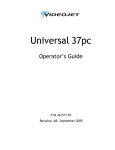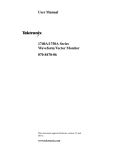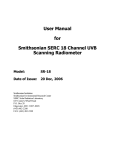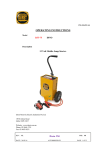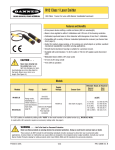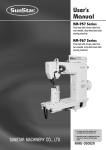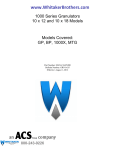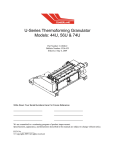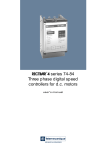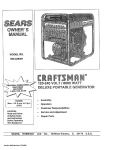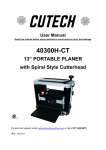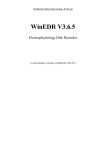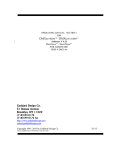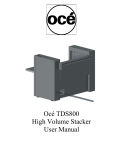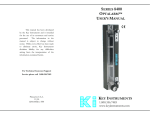Download Current Product Manual
Transcript
OPERATION AND MAINTENANCE MANUAL 2000 SERIES GRANULATORS CUMBERLAND ENGINEERING DIVISION COPYRIGHT 2004 ALL RIGHTS RESERVED REVISION 9/04 BJF PART NO. CI044120 1 CUMBERLAND ENGINEERING 2900 S. 160th Street NEW BERLIN, WI 53515 USA TEL: 1-262-641-8600 FAX: 1-262-641-8653 PARTS AND SERVICE TEL: 1-800-299-2919 FAX: 1-262-641-8615 MACHINE DATA MODEL______________________________________ SERIAL NUMBER____________________________________ CUMBERLAND CUSTOMER ORDER NUMBER___________________________ REVISION 9/04 BJF 2 TABLE OF CONTENTS TOPIC/SECTION PAGE INTRODUCTION……………………………………………………….xi Factory address… What is a granulator?……………………………………………………..xii A granulator is… The granulating of plastic… The size of the granulate… The disposal of plastic granulate… SECTION 1 – SAFETY Safety symbols and plates……………………...…………….………....1-1 Learn machine safety Safety alert symbol Understanding the signal words Follow the safety instructions…………………………………………..1-2 Rotating knives safety plate Warning – Pause after shutdown Opening, guards, covers safety plate Rotating machinery safety plate………………………………………..1-3 Opening hopper safety plate Rotating knives safety plate Warning shear hazard Guard’s safety plate Safety instruction plate………………………………………………….1-4 Hazardous voltage safety plate Rotating knives safety plate………………………………………….…1-5 Motor rotation safety plate Safety clothing and practices…………………………………………...1-6 Wear hearing protection Wear safety glasses Wear protective clothing………………………………………………..1-7 Keep your work area safe Keep co-workers off the machine Work safely……………………………………………………………..1-9 Be sure the rotor is motionless before opening machine Safely clearing a jam……………………………………………………..……1-10 Work safely Jackscrew operation REVISION 9/04 BJF 3 Open the cutting chamber Clear the jam……………………………………………………………1-11 Malfunction check Restart the granulator TABLE OF CONTENTS TOPIC/SECTION PAGE SECTION 2- MACHINE PARTS AND CONTROLS ……………………………………..2-1 2000 Series granulator left front quarter view 2000 Series granulator, right front quarter view ……………………….……………...2-2 2000 Series granulator, machine open front view 2000 Series granulator, left rear quarter view…………………………………….…... 2-3 2000 Series granulator, right rear quarter view SECTION 3 -INSTALLATION Overview……………………………………………………………………………… 3-1 Machine weights Uncrate the granulator Move the granulator to its work site…………………………………………………...3-2 Allow adequate workspace Level the granulator Work safely Remove the protective coating………………………………………………………...3-3 Check the knives and screens Power considerations Electrical wiring ………………………………………………………………………3-4 Work safely Check for mechanical interferences………………………………………………….. 3-5 Set up the machine functions Check rotation of motors Reverse the motor rotation if needed Interlock switch test procedure………………………………………………………. 3-6 Alternate test for the interlock switches Lubrication………………………………………………………………………….…3-7 SECTION 4 -SETTINGS AND ADJUSTMENTS Adjusting or replacing the bed knives………………………………………………... 4-1 Basic facts about the knives Check all settings and adjustments before granulating any material Malfunction check Work safely Open the cutting chambers interlock…………………………………..…….……...….4-2 Release the cutting chamber fasteners Open the cutting chamber……………………………………………………………. 4-3 Care in handling knives REVISION 9/04 BJF 4 Install the rotor-locating pin TABLE OF CONTENTS TOPIC/SECTION PAGE SECTION 4 -SETTINGS AND ADJUSTMENTS (Continued from previous page) Adjusting or replacing the bed knives (Continued from previous page) Loosen the mounting screws……………………………………………….4-4 Remove the first knife clamp or shield Remove the bed knives Clean the knife mounting surfaces…………………………………………4-5 Mounting screws Replace the upstroke bed knife Replace the upstroke knife clamp Replace the down stroke bed knife…………………………………………4-6 Replace the down stroke knife shields Check the bed knives Gap adjustment tips. Measure the knife gap……………………………………………………..4- 7 Set the down stroke knife shield Check the knife gap Tighten the screws to final torque…………………………………………4-8 Finalize installation of upstroke bed knife Close the cutting chamber Fasten the cutting chamber………………………………………………..4-9 Close the cutting chamber safety interlock Restart the granulator Adjusting or replacing rotor knives……………………………………. 4-10 Basic facts about the knives Work safely Open the cutting chamber interlock Release the cutting chamber fasteners……………………………………4-11 Open the cutting chamber Care in handling knives…………………………………………………..4-12 Lock the rotor Remove the mounting screws Remove the rotor knives Clean parts for reassembly………………………………………………..4-13 Adjust the bed knives Mounting screws Install the new or reground rotor knives Tighten the rotor knives to final torque…………………………………..4-14 Check the bed knives Gap adjustment tips REVISION 9/04 BJF 5 TABLE OF CONTENTS TOPIC /SECTION PAGE SECTION 4 SETTINGS AND ADJUSTMENTS (Continued from previous page) Adjusting or replacing bed knives (Continued from previous page) Measure the knife gap ………………………………………………...………4-14 Set the down stroke knife shield……………………………………………….4-15 Check the knife gap Tighten screws for final torque Close the cutting chamber……………………………………………………..4-16 Fasten the cutting chamber Close the cutting chamber safety interlock Restart the granulator Drive belt replacement and adjustment……………………………………………..4-17 Overview Work safely Remove the drive guard cover Inspect the drive belts…………………………………………………………4-18 Remove the belts Install the matched belts Tighten the belt tension Check the pulley alignment……….…………………………………………..4-19 Measure the belt span Calculate the allowable belt deflection Measure the deflection force Compare the measured force to recommended force…………………………4-20 Adjust the belt tension Tighten the motor base bolts Replace the drive guard cover………………………………………………...4-21 Restart the granulator Setting and adjusting the chamber jackscrew………………………………...4-22 REVISION 9/04 BJF 6 TABLE OF CONTENTS TOPIC /SECTION PAGE SECTION 5 -OPERATION Initial startup……………………………………………………………………………..5.1 Safety Check Work safely Check for mechanical interferences Check the motor rotation direction……………………………………………...5-2 Run the motor Discharge air adjustment SECTION 5 -OPERATION Normal operation………………………………………………………………………...5-4 Feed the machine Shut down the machine Discharge cleanout safety SECTION 6 -MAINTENANCE Periodic maintenance………………………………………………………...…6-1 Periodic Maintenance Schedule Lubrication…………………………………………………………………...…6-2 Knife screw torque Belt tension Screen condition In-feed flap condition……………………………………………………….…..6-3 Screen replacement……………………………………………………………..6-4 Work safely Open the screen cradle interlock Lower the screen cradle Remove the discharge Retract the screen cradle retainers Beware of rotor knives Remove the screen……………………………………………………………...6-5 Replace the screen Raise the screen cradle Close the screen cradle retainers REVISION 9/04 BJF 7 TABLE OF CONTENTS TOPIC/SECTION PAGE SECTION 6 -MAINTENANCE Screen replacement (Continued from previous page) Close the screen cradle interlock. ………………………………………………….6-6 Restart the granulator Cutting chamber access …………...…………………………………………..6-7 Work safely Open the cutting chamber interlock Release the cutting chamber fasteners Open the cutting chamber Close the cutting chamber Fasten the cutting chamber…………………………………………………………6-8 Close the cutting chamber safety interlock Restart the granulator Knife sharpening..………….…………………………………………………...6-9 Rotor knife sharpening Bed knife sharpening………………………………………………………………6-10 SECTION 7-TROUBLESHOOTING Overview………………………...……….……………………………….….…….7-1 Test equipment Locating trouble Troubleshooting chart Processing faults..…………………………………………………………..………7-2 Mechanical faults ………………………………………………………………….7-3 Electrical faults…………………………………………………………………….7-4 SECTI0N 8 -PARTS LISTS AND DRAWINGS Recommended Spare Parts..………………………………………………………..8-1 Parts identification Cumberland Drawing no. C1044035….………………..8-2 to 8-6 Rotor positioning/Locking assembly………………………………………………8-7 Overall dimensions Cumberland Drawing no. CI044063, CI044122 and CI044063-1………………………………………………………………….8-8 to 8-10 Wiring diagram Cumberland Drawing no………………………………………….8-11 REVISION 9/04 BJF 8 INTRODUCTION THANK YOU for purchasing a CUMBERLAND 2000-SERIES GRANULATOR. READ THIS MANUAL to learn how to operate and service your granulator safely. It covers the family of granulators called the 2000 Series. This series of Cumberland Granulators is designed for the big jobs in reclamation of thin-walled, injection-molded plastic parts, thermoforming sheet, as well as film. *NOTE: This manual covers light maintenance only. No further maintenance should be performed without first contacting the Cumberland Service Department at the mailing address and phone number shown below. When calling the factory for service information or for parts, please have the model and serial number of your machine on hand. The serial number is stamped on the plate mounted on center at the back of the granulator just below the hopper. ADDRESS, PHONE & FAX NUMBERS: CUMBERLAND ENGINEERING DIVISION 100 Roddy Avenue South Attleboro. MA 02703-7951 Telephone: 508-399-6400 Fax number: 508-399-6653 REVISION 9/04 BJF 9 INTRODUCTION WHAT IS A GRANULATOR? A GRANULATOR is a machine that is designed to size-reduce plastic materials to chips, or granulate. The machine can be fed either by hand through the hopper opening in the front or automatically from a special hopper opening, which can be specially designed. THE GRANULATING OF PLASTIC is achieved by the cutting action of sharp rotating knives in close adjustment to one or more stationary knives called bed knives. The rotary knife assembly is called a rotor. You will see many references to it as you read through this manual. There are two bed knives in the machines covered by this manual. The heavy-duty rotor and bed knife assemblies, combined with the screen (explained below) and their enclosing cutting chamber are the heart of the granulator. THE SIZE OF THE GRANULATE resulting from the cutting action described is controlled by a screen, which fits tightly around the rotary knives in the cutting chamber. The screen retains the plastic granulate until it is reduced to a small enough size to fall through the holes in the screen. Screens with various diameter hole sizes are available for the granulator. The standard screen hole size for the 2000-Series Granulators is 3/8" diameter. Screens are available with either smaller or larger diameter hole sizes. For a given machine, the throughput capacity of the granulator is dependent upon the size of the screen utilized. DISPOSAL OF THE PLASTIC GRANULATE takes place after it passes through the screen and drops into the discharge area, where it is removed from the machine by a discharge blower and conveyed by air to a remote collection system. The blower can be mounted on either side of the machine with its inlet located on the opposite side of the machine. The discharge blower is available as optional equipment. REVISION 9/04 BJF 10 SAFETY SECTION 1-1 Safety Symbols & Plates LEARN MACHINE SAFETY Read this manual. Learn how to operate the machine and how to use the controls properly. DO NOT ALLOW ANYONE TO OPERATE THIS MACHINE WITHOUT PROPER INSTRUCTIONS. THIS SAFETY alert symbol MEANS ATTENTION! BE ALERT! YOUR SAFETY IS INVOLVED! This symbol appears frequently in this manual and on your machine. It is used to alert you to the possibility of personal injury or death. Follow the instructions in the safety messages identified with this symbol. UNDERSTAND SIGNAL WORDS A signal word such as – DANGER, WARNING or CAUTION, is always used with the safety alert symbol to indicate the level of a potential hazard. These safety words are in accordance with ANSI Z535.5. Danger! – Identifies the most serious hazard. Disregard of this hazard will result in personal injury or death. The signal word is printed over a red background. Warning! – Identifies a hazard or unsafe practice. Disregard of this hazard will result in severe personal injury or death. The symbol is printed over an orange background. Caution! – Identifies a hazard or unsafe practice. Disregard of this could result in minor personal injury or product property damage. The signal word is printed over a yellow background. REVISION 9/04 BJF 11 SAFETY SECTION 1-2 Safety Symbols & Plates FOLLOW SAFETY INSTRUCTIONS: Read all the safety messages in this manual and on your machine safety plates. Follow the recommended precautions and safe operating practices. Keep safety plates in good condition. Replace missing or damaged plates. ROTATING KNIVES SAFETY PLATE (Located below the infeed opening at the front of the machine) Do not, under any circumstances, place your hands into the feed opening beyond the curtain while the machine is capable of running. Disconnect and lock out all power when it becomes necessary to work beyond this point. Make sure the rotor has come to a full stop before reaching through the curtain. WARNING -PAUSE AFTER SHUTDOWN (Located at the front of the cutting chamber) Pause, as suggested, after shutting the machine down and locking out the power even though safety interlocks are in place to prevent injury. Develop good safety habits by adhering to the messages on all the warning plates. The best safety provision is your own careful concentration on safety. OPENING HOPPER, GUARDS, COVERS SAFETY PLATE (Located on the screen cradle on the front panel, left of the machine center.) The hopper, guards, and safety covers are in place for your protection during machine operation. Be sure not to remove them until the rotor has come to a complete stop and you have disconnected and locked out the power. Be sure to replace all guard before reconnecting power. REVISION 9/04 BJF 12 SAFETY SECTION 1-3 Safety Symbols & Plates ROTATING MACHINERY SAFETY PLATE (One located on the machine guard on the left side of the machine, one on the screen cradle on the front panel, to the right of the machine center.) Avoid personal injury by making sure that the rotor is stopped and the power is disconnected and locked out before removing a machine guard. A motion sensor monitors the rotor and disables the jackscrew motors if there is rotor movement. If you see the rotor spinning after opening the machine, immediately shut down and call for service. OPENING HOPPER SAFETY PLATE (Located on center at the lower, front side of the hopper) Take the time for safety by disconnecting and locking out the power before opening the hopper. Work carefully and beware of all hazards with the hopper open and the knives exposed. ROTATING KNIVES SAFETY PLATE (One located near the discharge port and one located near the vent port on each side of the machine.) Never reach into the vent or discharge areas without shutting down the machine and locking out the power. Wear protective gloves whenever you work around the rotor knives and do not open the access doors to them until you are certain that the rotor has stopped and you have disconnected and locked out the power. To clear a jam, refer to the topic entitled Safely Clearing a Jam later in this section. GUARDS SAFETY PLATE (Located on the drive guard cover on the left side as you face the machine) By keeping the guards in place at all times you are promoting good safety practices and avoiding needless hazard and injury. REVISION 9/04 BJF 13 SAFETY SECTION 1-4 Safety Symbols & Plates SAFETY INSTRUCTION PLATE (Located on the front of the drive guard) The safety instruction plate summarizes the most important safety rules that you need to operate this machine safely. Read it carefully and observe it always to promote safe machine operation. HAZARDOUS VOLTAGE SAFETY PLATE (Located on the door of the jackscrew console) Always call for the services of a licensed electrician when you think that there is an electrical problem. Never open any electrical panel if you are not a licensed electrician. Touching the wrong terminals may result in serious injury or death. REVISION 9/04 BJF 14 SAFETY SECTION 1-5 Safety Symbols & Plates ROTATING KNIVES SAFETY PLATE (One located on the front of the cutting chamber and one on the front of the cradle) The rotating knives are razor-sharp to the touch. Always verify that the rotor is not moving. Avoid personal injury by making sure that the rotor is stopped and the power is connected and locked out before opening the machine. A motion sensor monitors the rotor and disables the jackscrew motors if there is movement. If you see the rotor spinning after opening the machine, immediately shut down the machine and call for service. Wear protective gloves whenever you work around the rotor knives. To avoid jamming your fingers between the rotor knives and the bed knives, refer to the information for safely clearing a jammed cutting chamber later in this section. Ref. No. SPI-O30 MOTOR ROTATION SAFETY PLATE (Located on the door of the jackscrew console) A REMINDER TO THE ELECTRICIAN to check the motor rotation. It is important to check the motor rotation whenever electrical connections to the motor are being made or have been disturbed for maintenance. The wrong rotation direction can cause personal injury (by throwing debris back toward the feed hopper opening) and/or by damaging the knives. *NOTE: The drive motor direction arrow plate is located on the top surface of the drive guard toward the front of the machine. REVISION 9/04 BJF 15 SAFETY SECTION 1-6 Safety Clothing and Practices (Located above the infeed opening at the front of the machine) It is recommended that hearing protection be used at all times when operating this equipment. It is mandatory that hearing protection be worn when noise exposure exceeds OSHA Standards Section 1910.95. (Located above the infeed opening at the front of the machine) Always wear proper eye protection when operating and/or servicing this equipment. Wear safety glasses with side shields or full-face safety shields. REVISION 9/04 BJF 16 SAFETY SECTION 1-7 Safety Clothing & Practices WEAR PROTECTIVE CLOTHING Never wear neckties, dangling jewelry, loose-fitting clothing, watches, bracelets, or rings. Tie back long hair or restrain it with a hair net to ensure your safety. KEEP YOUR WORK AREA SAFE Keep your work area clean and uncluttered. Store your maintenance tools away from the granulator to prevent them from falling into the machine and causing severe internal damage to the cutting chamber. KEEP CO-WORKERS OFF THE MACHINE Never lean or rest on the granulator. Do not let co-workers lean on your machine while it is running. A moving part or shower of material many cause unexpected injury. REVISION 9/04 BJF 17 SAFETY SECTION 1 Safety Clothing & Practices TURN OFF AND LOCKOUT the power per OSHA 1910.147 OR ANSI Z244.1-1982 (Lockout/Tag-out of Energy Sources). If it is not possible to lock out the power, have an electrician remove the fuses. Make sure the rotor has come to a complete stop. Wear gloves to protect against injury from the rotor or bed knives. BE SURE THE ROTOR IS MOTIONLESS BEFORE OPENING MACHINE Never open or remove any machine components unless the motor is electrically locked out and the rotor is completely motionless. REVISION 9/04 BJF 18 SAFETY SECTION 1-10 Safely Cleaning A Jam TURN OFF AND LOCKOUT the power per OSHA 1910.147 OR ANSI Z244.1-1982 (Lockout/Tag-out of Energy Sources). If it is not possible to lock out the power, have an electrician remove the fuses. Make sure the rotor has come to a complete stop. Wear gloves to protect against injury from the rotor or bed knives. OPEN THE CUTTING CHAMBER Open the screen cradle per instructions in Section 6 entitled Screen Replacement. Open the cutting chamber per instructions in Section 6 entitled Cutting Chamber Access. NEVER ATTEMPT TO FREE A JAMMED MACHINE BY PLACING YOUR HANDS ON THE ROTOR, ON THE KNIVES, OR INSIDE THE CUTTING CHAMBER. KEEP YOUR HANDS CLEAR OF THE ROTATIONAL PATH OF THE ROTOR KNIVES. REVISION 9/04 BJF 19 SAFETY SECTION 1-11 Safely Cleaning A Jam CLEAR THE JAM A leather mallet and block of wood of sufficient length to keep hands away from the path of the knives can be used if required. Use the block of wood to exert force on the rotor, usually in the direction opposite normal rotation. Make sure you have secure footing on a clean floor and keep your body well braced while prying on the rotor. Guard against loss of balance should the jammed condition suddenly come free. Use pliers to remove material from the cutting chamber, keep in mind that the removal of material may cause rotation of the rotor and rotor knives. If prying on the rotor is unsuccessful, remove the bed knife and the rotor knife at the jam. For information about bed knives, refer to Section 4, Settings and Adjustments. Close the screen cradle per instructions in Section 6 entitled Screen Replacement Close the cutting chamber per instructions in Section 6 Cutting Chamber Access. A malfunction of the machine, such as a jam, may cause undue strain or damage to any part. Do not restart the machine after such a malfunction without checking to see whether damage was done or whether settings were changed by the malfunction. RESTART THE GRANULATOR If necessary to replace the fuses, call an electrician to do it. UNLOCK AND TURN ON the main power. Remove the OUT OF SERVICE tag, start the granulator by depressing the start pushbutton on the electrical cabinet. REVISION 9/04 BJF 20 MACHINE PARTS AND CONTROLS SECTION 2-1 1. 2. 3. 4. 5. 6. 7. 8. 9. 10. 11. 12. Hold-down clamps - cutting chamber Screen cradle retainers Interlock actuator screw – cutting chamber Safety plates Feed hopper Rotor bearing housing (Not shown) Discharge duct (Optional mount to either side) Start/Stop pushbuttons located on the electrical cabinet, not shown (Cabinet is option equipment) Hopper opening screw jack Drive guard Hopper flap Rotor lock mechanism (Between guard and chamber) The 2000 series granulators have a common cutting diameter of 20” (500mm) and a common throat size of 20” (500mm) by widths ranging from up to 62” (1575mm). They are designed for reclamation of large blow-molded and thin walled injection molded parts, films and fibers. The machines in the 2000 Series can be fitted with screens having hole sizes to suit the particular application. The 2000- Series machines conform to ANSI Standards: B151.11 and NFPA 79. REVISION 9/04 BJF 21 MACHINE PARTS AND CONTROLS SECTION 2-2 22000000 –– SSeerriieess G Grraannuullaattoorr p e n M a c h i n e O Viieew w Machine Open FFrroonntt V 1. Screen 2. Rotor Knife 3. Bed Knife (Down-stroke) 4. Rotor locking mechanism 5. Drive guard 6. Flywheel guard (Optional) REVISION 9/04 BJF 22 MACHINE PARTS AND CONTROLS SECTION 2-3 22000000 –– sseerriieess G Grraannuullaattoorr LLeefftt R e a r Q u Rear Quaarrtteerr V Viieew w 1. Hopper jack screen (50” & 62” wide machines will be equipped with an hydraulic system for opening the hopper) 2. Screen cradle gas spring 3. Screen cradle 4. Discharge chute 5. Discharge outlet pipe REVISION 9/04 BJF 23 INSTALLATION SECTION 3-1 OVERVIEW This section deals with the procedures required to place your 2000 Series Granulator into service after you receive it at your plant. The following basic steps need to be accomplished. Uncrating the machine Accounting for all necessary parts Inspecting for damage and reporting any damage to the carrier Cleaning the protective coating from the machine Moving the machine to its service location Checking and, if necessary, adjusting mechanical parts before applying electrical power Performing the start-up procedure PLEASE FOLLOW THESE STEPS AS OUTLINED TO ACHIEVE A SAFE AND SUCCESSFUL START UP OF YOU 2000 SERIES GRANULATOR. The machine weights for the 2000 – Series Ganulators are as follows: 2042…….11,000 lbs. 2050…….12,750 lbs 2062…….14,500 lbs UNCRATE THE GRANULATOR As shipped, the granulator and the hopper are securely bolted onto separate skids and covered with a wooden crate. The electrical cabinet, an optional item, is similarly packaged when ordered. Remove the strapping Remove the packages and parts from the skid or inner sides of the crate Remove the hold-down bolts, nuts, etc. Inspect for damage during transit and notify the carrier immediately of any damage. Check the packing list and notify Cumberland if there are any shortages. REVISION 9/04 BJF 24 INSTALLATION SECTION 3-2 MOVE THE GRANULATOR TO ITS WORK SITE If lifting the machine is necessary, use appropriately rated lifting equipment. Always lift the unit from beneath the base plate. The machine WEIGHTS FOR THE 2OOO SERIES are as follows: 2042…….11,000 lbs. 2050…….12,750 lbs 2062…….14,500 lbs LEVEL THE GRANULATOR Once the granulator is at its final installation site, ensure that the machine is on a level surface and resting firmly on its base-plate. If necessary, use shims to level it. It can be mounted on isolation pads or it can be lagged to the floor through holes provided in the base plate. ALLOW ADEQUATE WORK SPACE Adequate clearance must be maintained so that all areas of the granulator are accessible and unobstructed for servicing, maintaining, or operating the equipment. Space must be allowed for removing guards and screens. Allow three feet (91 cm) on all sides of the machine for access. TURN OFF AND LOCKOUT the power per OSHA 1910.147 OR ANSIZ244:1-1982 (Lockout/Tag-out of Energy Sources). If it is not possible to lock out the power, have an electrician remove the fuses. . Make sure the rotor has come to a complete stop. (Continued on next page) REVISION 9/04 BJF 25 INSTALLATION SECTION 3-3 REMOVE THE PROTECTIVE COATING The machine is shipped with a protective wax coating, which must be removed prior to start-up. The coating can be removed with an acceptable solvent, such as mineral spirits. Clean the following areas: Inside the feed hopper Inside the cutting chamber (knives, rotor, etc.) Inside the discharge area. CHECK THE KNIVES AND SCREENS Be sure that the screens are properly installed into the cutting chamber and that nothing has fallen into the cutting chamber during transportation and/or installation. Refer to Section 6, Maintenance, for the procedure entitled Screen Replacement and Cutting Chamber Access. Check to be sure the bed knife and rotor knife hold-down screws are tight and knife clearances are correct. Refer to Section 4, Settings and Adjustments. POWER CONSIDERATIONS Before operating the granulator, it is extremely important that a licensed electrician correctly wires the machine into the plant power source. See Section 8, for wiring diagram. All electrical equipment must be properly grounded in accordance with local and national codes to protect personnel from electrical shock. A fusible, lockable disconnect between the plant power source and the machine electrical cabinet is highly recommended. REVISION 9/04 BJF 26 INSTALLATION SECTION 3-4 ELECTRICAL WIRING To wire the granulator, run power (of proper voltage) from the plant source through a lockable, fusible disconnect to the machine electrical control panel. 50” & 62” machines are equipped with a hydraulic system for opening the hopper. To wire the hydraulic controls, run power (of proper voltage) from the plant source through a lockable, fusible disconnect to the machine-mounted control panel. From the main electrical panel, make the necessary wiring connections to the main drive motor and any auxiliary motors or control connections. Refer to the diagram appended to this manual for wiring connections for typical machine applications, Check the wiring diagram supplied for any wiring that is specific to you application. This diagram is part of the documentation shipped with the machine. After power is connected, do not make any adjustments to the machine without performing the following operations. TURN POWER OFF and LOCK IT OUT per OSHA 1910.147 or ANSI Z244.1-1982 If you cannot lock out power, have an electrician remove the fuses. Tag the machine as OUT OF SERVICE. Make sure the rotor has come to a complete stop. Wear gloves to protect against injury from the rotor or bed knives. REVISION 9/04 BJF 27 INSTALLATION SECTION 3-5 CHECK FOR MECHANICAL INTERFERENCES TURN POWER OFF and LOCK IT OUT per OSHA 1910.147 OR ANSI Z244.1-1982 (Lock-out/Tag-out of Energy Sources). Open the cutting chamber. Refer to the procedures entitled Screen Replacement and Cutting Chamber Access in Section 6. Turn the rotor slowly with gloved hands, at least one full revolution, to verify that there are no interferences between the rotor knives and bed knives and/or with the screen. SET UP THE MACHINE FUNCTIONS Set and torque the rotor knives and bed knives as shown in Section 4, Settings and Adjustments. Adjust the V-belt drive per the procedure in Section 4 entitled Drive Belt Replacement or Adjustment. CHECK ROTATION OF MOTORS With the cutting chamber closed, jog the drive motor by pushing the start and stop buttons in quick succession. This starts and stops the granulator motor. Be alert for mechanical interferences between parts. Stop the machine immediately if you hear unexpected sounds. Jog the motor to check the rotational direction. The V-belt sheave must rotate in the direction shown by the arrow located on top of the belt guard. Have a helper confirm the direction by looking at the V-belt /pulley through the viewing window on the side of the belt guard cover. If your unit has the optional discharge blower located on either the right or left side of the machine, check the direction of rotation of the blower. IF NECESSARY, REVERSE THE MOTOR ROTATION It is extremely important that a licensed electrician performs these steps. If any motor rotates in the wrong direction, stop the machine by depressing the stop button. TURN OFF AND LOCK OUT the power at the disconnect switch which supplies power to the main electrical control panel per OSHA 1910.147 OR ANSI Z244.1-1982 (Lock-out/Tag-out of Energy Sources). If the disconnect is not lockable, remove the fuses. (Continued on next page) REVISION 9/04 BJF 28 INSTALLATION SECTION 3-6 IF NECESSARY, REVERSE THE MOTOR ROTATION WARNING! With all power to the electrical control panel disconnected and locked out, reverse any two of the three power line conductors to the machine. If there is more than one motor on the machine, and one is turning in the wrong direction, and one isn't: reverse any two of the three line conductors at the overload relay of the motor that you wish to reverse. Unlock the power and switch it on at the electrical disconnect (if necessary, replace the fuses). Re-check the rotation direction of the motor(s). INTERLOCK SWITCH TEST PROCEDURE With the machine stopped, perform the following steps: TURN OFF and LOCK OUT THE POWER per OSHA 1910.147 OR ANSI Z244.1-1982 (Lock-out/ Tag-out of Energy Sources). Use the wiring diagram appended to this manual to locate the interlock switch terminal strip in the junction box control panel. The wires for the upper chamber interlock switch are numbers 1 and 16. The wires for the screen cradle interlock switch are numbers 16 and 5. Connect an ohmmeter across each interlock switch terminal or across all interlock switch terminals (wire numbers 1 and 5). Switch the ohmmeter resistance to the lowest scale. When the interlock actuator screws are in place and properly activating their switches, the ohmmeter should read zero resistance. When either or both actuator bolts are withdrawn, the ohmmeter should read infinite resistance. Loosen ONE actuator screw 3 to 4 turns. If, the meter reads INFINITY, before the screw can be completely removed, the INTERLOCK IS WORKING. If the meter reads ZERO RESISTANCE, when the actuator screw is completely REMOVED, the INTERLOCK IS NOT WORKING. REPLACE THE FIRST ACTUATOR SCREW TESTED BEFORE TESTING THE SECOND ONE. If an interlock does not work, the complete mechanism, including the switch, must be removed and disassembled to determine the cause of the malfunction. ALTERNATE TEST FOR THE INTERLOCK SWITCHES With the cutting chamber and screen cradle closed and power on perform the following steps: Push the start button to start the granulator. Retract the screen cradle interlock actuator screw by turning it counterclockwise. The granulator should stop after several turns. If the machine continues to run, TURN OFF AND LOCK OUT THE POWER per OSHA 1910.147 OR ANSI Z244.1-1982 (Lock-out/tag-out of Energy Sources). Have the electrician check the interlock switch on the screen cradle to correct the malfunction. (Continued on next page) REVISION 9/04 BJF 29 INSTALLATION SECTION 3-6 ALTERNATE TEST FOR THE INTEROCK SWITCHES (Continued from previous page) After the test or repair, engage the screen cradle interlock actuator screw. If necessary, unlock and turn on the power. Push the start button to start the granulator. Retract the cutting chamber interlock actuator screw by turning it counterclockwise. The granulator should stop after several turns. If the machine continues to run, TURN OFF AND LOCK THE POWER per OSHA 1910.147 or ANSI Z244.1-1982 (Lock-out/Tag-out of energy sources). Have an electrician check the interlock switch on the cutting chamber to correct the malfunction. After the test or repair, if necessary, engage the cutting chamber interlock actuator screw. TEST THE ZERO SENSOR (Optional) - STANDARD with 50” & 62” Wide Machine Depress the button to start the granulator. When the machine reaches full speed, depress the stop button to stop the granulator. Release the cutting chamber hold-down clamps using the procedures in Section 6 entitled Cutting Chamber Access. While the rotor is still turning, actuate the hopper opening hydraulic system console by turning the CC/Hopper selector switch to the RAISE position. The hydraulic system should not operate until the rotor has come to a complete stop. If the hydraulic system operates before the rotor stops, TURN OFF AND LOCKOUT THE POWER per OHSA 1910.147 or ANSI Z244.1-1982 (Lock-out/Tag-out Energy Sources). Have a mechanic and electrician check the speed sensor. LUBRICATION The machine is pre-lubricated except for the motor. For motor lubrication, check the tag supplied by the motor manufacturer. After the 2000-Series Granulator has been in service for some time, the main bearings should be periodically lubricated. Refer to Section 6, Maintenance, for further information. REVISION 9/04 BJF 30 SETTINGS AND ADJUSTMENTS SECTION 4-1 Adjusting or Replacing Bed Knives BASIC FACTS ABOUT THE KNIVES All of the rotor knives are ground in sets to equal dimensions. Mount and service them as sets. The rotor knives must be mounted tightly against the backs of the knife seats in order to make it possible to achieve consistent knife clearances. Accurate cutting clearance is obtained by setting the bed knives to a 0.006 in. to 0.008 in. (0.15mm to O.20m) gap from the rotor knives. The bed knives are adjusted by turning the PUSH screws. For best results, start with the bed knives adjusted to a wide gap from the rotor knife and slowly adjust them to the required gap by turning the PUSH screws in the same direction. CHECK ALL SETTINGS AND ADJUSTMENTS BEFORE GRANULATING ANY MATERIAL Proper adjustments and settings are made prior to shipment, however the machine may require readjustment. The standard knife gap setting is between six and eight thousandths of an inch (0.006 in. to 0.008 in. or 0.15 mm to 0.20 mm). NOTE: These instructions apply to both the upstroke (the bed knife furthest from you when you service the cutting chamber) and the down-stroke bed knives. WORK SAFELY TURN OFF AND LOCKOUT the power per OSHA 1910.147 OR ANSI Z244.1-1982 (Lockout/Tag-out of Energy Sources). If it is not possible to lock out the power, have an electrician remove the fuses. Make sure the rotor has come to a complete stop. MALFUNCTION CHECK A malfunction of the machine, such as a jam, may cause undue strain or damage to any part. Do not restart the machine after such a malfunction without checking to see whether damage was done or whether settings were changed by the malfunction. REVISION 9/04 BJF 31 SETTINGS AND ADJUSTMENTS SECTION 4-2 Adjusting or Replacing Bed Knives OPEN THE CUTTING CHAMBER INTERLOCK Disengage the interlock actuator screw with a box wrench or a ratchet wrench. Make sure the end of the interlock actuator screw is visible and clear of any contact. When disengaged, the interlock opens the electrical control circuit to the motor and prevents the machine from running. RELEASE THE CUTTING CHAMBER FASTENERS Turn the hold-down clamps counterclockwise to loosen them. Swing the hold-down clamps toward you until they are disengaged from the cutting chamber housing. REVISION 9/04 BJF 32 SETTINGS AND ADJUSTMENTS SECTION 4-3 Adjusting or Replacing Bed Knives OPEN THE CUTTING CHAMBER The Jackscrew, which opens the machine, should never be operated until the rotor is completely stopped. Make sure that no one is near the Jackscrew or the hopper during operation. Turn the Jackscrew crank handle until the hopper opens sufficiently to allow access to the cutting chamber and the weight of the hopper is over the pivot center. NOTE: 50” and 62” machines are equipped with a hydraulic system to open the machine. CARE IN HANDLING KNIVES The rotor knives and bed knives are very sharp. Wear heavy gloves to avoid injury. Use the rotor lock mechanism to lock the rotor into position that is least likely to cause injury while you work. The mechanism will keep the rotor from turning. A block of wood wedged around the rotor, can also be used to lock the rotor in place. If the rotor knives and bed knives are to be removed, remove the rotor knives first (and then replace them last) to reduce the chance of injury. ENGAGE THE ROTOR LOCK MECHANISM Locate the rotor lock mechanism on the left side of the granulator, between the belt guard and the bearing housing. Pull the locking pin & rotate the plunger until it comes in contact with the flywheel locking the rotor position. Re-install the pin to maintain locked position. REVISION 9/04 BJF 33 SETTINGS AND ADJUSTMENTS SECTION 4-4 Adjusting or Replacing Bed Knives LOOSEN THE MOUNTING SCREWS Select either the upstroke knife or the downstroke knife for first removal. Loosen the bed knife screws with a 30 mm socket mounted on a breaker bar. These screws are tightened to a torque of 472 ft lbs (640 Nm) so make sure you have the proper breaker bar (a four foot long (1.2 m) bar with a 3/4 inch (19 mm) drive is suggested). Make sure you have solid footing while you apply the breaking force. REMOVE THE FIRST KNIFE CLAMP OR SHIELD Remove the screws on one half of the selected bed knife using a 30mm socket or equivalent wrench. *NOTE: When removing the knife clamp on the upstroke knife (the similar piece on the down-stroke knife is called knife shield), hold the clamp while removing the last screw to keep it from slipping off its inclined mounting surface. The knives will not slip off because the captive adjusting screws secures them. Keep the screws for reinstallation or use new factory-supplied screws of the same specification for replacement. Repeat the removal procedure for the remaining knife clamps and shields. REMOVE THE BED KNIVES Remove the bed knives by lifting each half until the knife clears the push screw and block. Remove the second bed knife using the same procedure. REVISION 9/04 BJF 34 SETTINGS AND ADJUSTMENTS SECTION 4-5 Adjusting or Replacing Bed Knives CLEAN THE KNIFE MOUNTING SURFACES Clean the knife mounting surfaces with a stone or other non-marring tool and wipe them with a clean cloth. Make sure they are free of all material, dust, and dirt. MOUNTING SCREWS DANGER! DO NOT REPLACE THE MOUNTING SCREWS WITH ANY TYPE OF SCREW OTHER THAN THAT SPECIFIED BY CUMBERLAND. Substitution of improper screws could lead to premature failure, equipment damage, and serious injury to personnel. When regrinding the knives: you may re-use the same screws and washers, but do not re-use them more than six times. When installing new knives, replace the screws and washers with those furnished by the factory. REPLACE THE UPSTROKE BED KNIFE Wipe the screws with a lightly oiled cloth; do not leave an oil film since lubrication can adversely affect the stress on a screw installed to a fixed torque. Install the upstroke knife making sure to install it with the knife-edge on the lower side. Back off the bed knife push screws at the rear of the knife. Repeat these steps for the second half of the knife. REPLACE THE UPSTROKE KNIFE CLAMP Place the clamp over one half of the knife and hold it in position until you fasten the first two screws and washers fingertight. Place the second clamp over the second half of the knife and hold it while you fasten it. Install the remaining mounting screws and washers and tighten them finger-tight. REVISION 9/04 BJF 35 SETTINGS AND ADJUSTMENTS SECTION 4-6 Adjusting or Replacing Bed Knives REPLACE THE DOWNSTROKE BED KNIFE Install the down-stroke bed knife (located on the near side of the rotor) making sure to install it with the knife-edge on the upper side. Back off the bed knife push screws at the rear of the knife. Repeat these steps for the second half of the downstroke knife. REPLACE THE DOWNSTROKE KNIFE SHEILDS Place the shields over the bed knife. Install the mounting screws and washers and tighten them finger-tight. CHECK THE BED KNIVES Check both halves of the upstroke knife (the bed knife on the far side of the rotor) to be sure that the cutting edges face down. Check both halves of the down-stroke knife (the bed knife on the near side of the rotor) to be sure that the cutting edges face up. GAP ADJUSTMENT TIPS It is best to keep the adjustments on the bed knife push screws moving in the same direction. This eliminates the effect of backlash in the adjusting screw. Make the screw adjustments in small steps to keep the bed knife adjustment even over the width of the machine. To avoid cutting the shim stock, turn the rotor backward during the adjustment procedure. Use the rotor knife with the largest dimension from rotor centerline as the reference, i.e., the highest knife. REVISION 9/04 BJF 36 SETTINGS AND ADJUSTMENTS SECTION 4-7 Adjusting or Replacing Bed Knives MEASURE THE KNIFE GAP If you are changing the rotor knives, do so now, otherwise continue with this procedure. Use brass shim stock to set the knife gap to the cutting clearance of 0.006 in. to 0.008 in. (0.15 mm to 0.20 mm). Remove the rotor-locating pin. (See page 4.3) Rotate the rotor backward, by hand, and measure the gap between it and the bed knife at the point of shear. You can work on each half of the bed knife independent of the other half but keep them in step with each other by working from side-to-side. SET THE DOWNS1ROKE KNIFE SHIELD Position the knife-shield so that it sets back from the bed knife-edge about 1/32 in. for film and 1/16 in. for thicker materials. Use a plastic or leather mallet, if necessary, to tap the shield or knife. The upstroke knife clamp does not need this adjustment, and snug down the mounting screws with a 30 mm socket wrench. Carefully adjust the bed knife clearance to its final setting. CHECK THE KNIFE GAP Snug the screws down in stages keeping them about even as you progressively tighten them. Recheck the knife gap after snugging down the mounting screws. ) After setting up to one rotor knife (usually the highest knife), rotate the remaining knives slowly by the bed knife and quickly verify the knife gap. REVISION 9/04 BJF 37 SETTINGS AND ADJUSTMENTS SECTION 4-8 Adjusting or Replacing Bed Knives TIGHTEN THE SCREWS TO FINAL TORQUE When the knife gap is adjusted to the proper dimension, tighten the mounting screws to a torque of 472 ft lbs (640 Nm). For safety, make sure that you have solid footing when you apply this final torque. Recheck the gap after tightening the screws to the final torque. Make sure that both halves of the bed knife are adjusted. FINALIZE INSTALLATION OF UPSTROKE BED KNIFE To complete the installation of the upstroke bed knife, use the same procedures as for the down-stroke knife. The titles follow: Measure the knife gap. Unlike the knife shield, the knife clamp does not need to be adjusted. Check the knife gap. Tighten the screws to final torque. CLOSE THE CUTTING CHAMBER WARNING! Make sure there is no one near the Jackscrew or Hopper. Clear the mating surfaces of the cutting chamber of any debris that might prevent tight closer. Check the rotor locking mechanism and back out the plunger if necessary. At the jackscrew, turn the crank handle till the hopper stops. On 50” and 62” machines, activate the hydraulic system to close the hopper. REVISION 9/04 BJF 38 SETTINGS AND ADJUSTMENTS SECTION 4-9 Adjusting or Replacing Bed Knives FASTEN THE CUTTING CHAMBER Raise the hold-down clamps to their upright positions Turn the knobs clockwise until they are tight against the chamber housing. CLOSE THE CUTTING CHAMBER SAFETY INTERLOCK Engage the safety interlock by turning the actuator screw clockwise with a box wrench or a ratchet wrench Make sure the screw is fully seated against the surface of its housing. When engaged, the interlock closes the electrical control circuit to the motor and allows the machine to run. RESTART THE GRANULATOR If necessary to replace the fuses, call an electrician to do it. UNLOCK AND TURN ON the main power. Remove the OUT OF SERVICE tag. Be sure the rotor lock mechanism is not engaged. Start the granulator by depressing the start pushbutton on the electrical cabinet. REVISION 9/04 BJF 39 SETTINGS AND ADJUSTMENTS SECTION 4-10 Adjusting or Replacing Rotor Knives BASIC FACTS ABOUT THE KNIVES All of the rotor knives are ground in sets to equal dimensions. Mount and service them as sets. The rotor knives must be mounted tightly against the backs of the knife seats in order to make it possible to achieve consistent knife clearance. Accurate cutting clearance is obtained by setting the bed knives to a 0.006 in. to 0.008 in. (0.15mm to 0.20mm) gap from the rotor knives. The knives are adjusted by turning captive adjusting screws. For best results, start with the bed knives adjusted to a wide gap from the rotor knife, and slowly adjust them to the required gap by turning the screws in the same direction; avoid reversals. Reversals introduce inaccuracies due to backlash. WORK SAFELY WARNING! TURN OFF AND LOCKOUT the power per OSHA 1910.147 OR ANSI Z244.1-1982 (Lock-out/Tag-out of Energy Sources). If it is not possible to lock out the power, have an electrician remove the fuses. Make sure the rotor has come to a complete stop. Wear gloves to protect against injury from the rotor or bed knives. OPEN THE CUTTING CHAMBER INTERLOCK Disengage the interlock actuator screw with a box wrench or a ratchet wrench. Make sure the end of the interlock actuator screw is visible and clear of any contact. When disengaged, the interlock opens the electrical control circuit to the motor and prevents the machine from running. REVISION 9/04 BJF 40 SETTINGS AND ADJUSTMENTS SECTION 4-11 Adjusting or Replacing Rotor Knives RELEASE THE CUTTING CHAMBER FASTENERS Turn the hold-down clamps counterclockwise to loosen them. Swing the hold-down clamps toward you until they are disengaged from the cutting chamber housing. OPEN THE CUTTING CHAMBER The jackscrew, which opens the machine, should never be operated until the rotor is completely stopped. Make sure no one is near the jackscrew or the hopper during operation. Turn the jackscrew crank handle until the hopper opens sufficiently to allow access to the cutting chamber and the weight of the hopper is over the pivot center. *NOTE: 50” and 62” machines are equipped with a hydraulic system to open the hopper. REVISION 9/04 BJF 41 SETTINGS AND ADJUSTMENTS SECTION 4-12 Adjusting or Replacing Rotor Knives CARE IN HANLDING KNIVES WARNING! The rotor knives and bed knives are very sharp; therefore, it is imperative that you wear a pair of heavy gloves to avoid injury. Use the rotor locking mechanism to lock the rotor in the least likely position to cause you injury while you work. The locking mechanism keeps the rotor from turning. A block of wood wedged around the rotor can also be used to lock to rotor in place. If the rotor knives and bed knives are to be removed, remove the rotor knives first and replace them last to reduce the chance of injury. LOCK THE ROTOR Locate the rotor lock mechanism on the left side of the granulator, between the belt guard and bearing housing. Pull the locking pin and rotate the plunger until it comes in contact with the flywheel, locking the rotor position. Re-install the pin to maintain locked position. REMOVE THE MOUNTING SCREWS Loosen the rotor knife screws with a 30 mm socket mounted on a breaker bar (These screws are tightened to a torque of 472 ft lbs (640 Nm) so make sure you have the proper breaker bar (a four foot long (1.2 m) bar with a 3/4 inch (19 mm) drive is suggested. Make sure you have solid footing while you apply the breaking force. Remove the mounting screws from the right rotor knife with a suitable socket wrench. REMOVE THE ROTOR KNIVES Lift the right knife off from the rotor and repeat the process with the left rotor knife. Remove the rotor-locating pin, turn the rotor to bring the next knives into position for removal, insert the locating pin to hold the rotor in this position. Repeat the process for the remaining knives. REVISION 9/04 BJF 42 SETTINGS AND ADJUSTMENTS SECTION 4-13 Adjusting or Replacing Rotor Knives CLEAN PARTS FOR REASSEMBLY Clean the rotor knife seats with a stone or other nonmarring tool. Make sure that the backs of the knife seats are clean so that the rotor knife can be placed squarely against them. Wipe the screws with lightly oiled cloth, do not leave an oil film since lubrication can adversely affect the stress on a screw installed to a fixed torque value. ADJUST THE BED KNIVES If the bed knives are installed, make sure that they are set back a sufficient amount to avoid interference with the new or reground rotor knives. MOUNTING SCREWS DO NOT REPLACE THE MOUNTING SCREWS WITH ANY TYPE OF SCREW OTHER THAN THAT SPECIFIED BY CUMBERLAND. Substitution of improper screws could lead to premature failure, equipment damage, and serious injury to personnel. When regrinding the knives, you may re-use the same screws and washers but do not re-use them more than six times. When installing new knives, replace the screws and washers with those furnished by the factory. INSTALL THE NEW OR REGROUND ROTOR KNIVES Engage the rotor lock mechanism. Place the first half rotor knife onto the rotor with the beveled edge facing up and toward you This leaves the backside of the knife sitting squarely against the back of the knife seat on the rotor. Center the knife mounting holes over the rotor mounting holes and install the screws. Tighten the screws finger- tight while holding the knife snug against the back of the knife seat. REVISION 9/04 BJF 43 SETTINGS AND ADJUSTMENTS SECTION 4-14 Adjusting or Replacing Rotor Knives TIGHTEN THE ROTOR KNIVES TO FINAL TORQUE Use a 30rnm socket wrench to tighten the mounting screws on each knife in small steps keeping them about even as you increase the torque on them. Use a torque wrench to apply the final torque of 472 ft lbs (640 Nm) to the mounting screws. Make sure your footing is secure before you apply the final torque. Check with a 0.0015" (0.04 mm) feeler gage to ensure that each knife is snug against the knife seat. CHECK THE BED KNIVES If the bed knives have been removed, check them as follows: Check both halves of the upstroke knife (the bed knife on the far side of the rotor) to be sure that the cutting edges face down. Check both halves of the down-stroke knife (the bed knife on the near side of the rotor) to be sure that the cutting edges face up. GAP ADJUSTMENT TIPS It is best to keep the adjustments on the bed knife push screws moving in the same direction. This eliminates the effect of backlash in the adjusting screw. Make the screw adjustments in small steps to keep the bed knife adjustment even over the width of the machine. To avoid cutting the shim stock, turn the rotor backward during the adjustment procedure. Use the rotor knife with the largest dimension from rotor centerline as the reference, i.e., the highest knife. MEASURE THE KNIFE GAP Use brass shim stock to set the knife gap to the cutting clearance of 0:006 in. to 0.008 in. (0.15 mm to 0.20 mm). Remove the rotor-locating pin, and back out the plunger. Rotate the rotor backward, by hand, and measure the gap between it and the bed knife at the point of shear. You can work on each half of the bed knife independent of the other half but keep them in step with each other by working from side-to-side. REVISION 9/04 BJF 44 SETTINGS AND ADJUSTMENTS SECTION 4-15 Adjusting or Replacing Rotor Knives SET THE DOWNSTROKE KNIFE SHIELD Position the knife-shield so that it sets back from the bed knifeedge about 1/32 in. for film and 1/16 in. for thicker materials. Use a plastic or leather mallet, if necessary, to tap the shield or knife. The upstroke knife clamp does not need this adjustment. Carefully adjust the bed knife clearance to its final setting and snug down the mounting screws with a 30 mm socket wrench. CHECK THE KNIFE GAP Snug the screws down in stages keeping them about even as you progressively tighten them. Recheck the knife gap after snugging down the mounting screws. After setting up to one rotor knife (usually the highest knife), rotate the remaining knives slowly by the bed knife and quickly verify the knife gap. TIGHTEN THE SCREWS TO FINAL TORQUE When the knife gap is adjusted to the proper dimension, tighten the mounting screws to a torque of 472 ft pounds (640 Nm). For safety, make sure that you have solid footing when you apply this final torque. Recheck the gap after tightening the screws to the final torque. Make sure that both halves of the bed knife are adjusted. REVISION 9/04 BJF 45 SETTINGS AND ADJUSTMENTS SECTION 4-16 Adjusting or Replacing Rotor Knives CLOSE THE CUTTING CHAMBER Make sure that no one is near the hopper. Clear the mating surfaces of the cutting chamber of and debris that might prevent closure. REMOVE THE ROTOR LOCKING PIN and back out the plunger, turn the handle until the hopper stops. Do not continue to turn the crank after the hopper has stopped. On 50” and 62” machines, activate the hydraulic system to close the hopper. FASTEN THE CUTTING CHAMBER Raise the hold-down clamps to their upright positions. Turn the knobs clockwise until they are tight against the chamber housing. CLOSE THE CUTTING CHAMBER SAFETY INTERLOCK Engage the safety interlock by turning the actuator screw clockwise with a box wrench or a ratchet wrench. Make sure the screw is fully seated against the surface of its housing. When engaged, the interlock closes the electrical control circuit of the motor and allows the machine to run. RESTART THE GRANULATOR If necessary to replace the fuses, call an electrician to do it. UNLOCK AND TURN ON the main power. Remove the OUT OF SERVICE tag. Be sure the rotor locking mechanism is not engaged. Start the granulator by depressing the start pushbutton on the electrical cabinet. REVISION 9/04 BJF 46 SETTINGS AND ADJUSTMENTS SECTION 4-17 Drive Belt Replacement Or Adjustment OVERVIEW Belt tension is important to the proper operation of the drive system of your granulator. Improper belt tension can lead to excessive belt wear and/or undue bearing wear on the rotor and motor bearings. This procedure shows you how to access the drive belts and how to adjust the tension to recommended levels. It also shows you how to replace the belts. WORK SAFELY TURN OFF AND LOCKOUT the power per OSHA 1910.147 OR ANSI Z244.1-1982 (Lockout/Tag-out of Energy Sources). If it is not possible to lock out the power, have an electrician remove the fuses. Make sure the rotor has come to a complete stop. Wear gloves to protect against injury from the rotor or bed knives. REMOVE THE DRIVE GUARD COVER Use a socket wrench to remove the fasteners that retain the drive guard cover. Remove the cover. REVISION 9/04 BJF 47 SETTINGS AND ADJUSTMENTS SECTION 4-18 Drive Belt Replacement Or Adjustment INSPECT THE DRIVE BELTS Check the belts for cracks in the V-sections that ride in the pulley grooves as well as on the outside surface of the belts. Also look for signs of excessive wear. If replacement is necessary, continue with the steps that follow. If it is not necessary to replace the belts, skip ahead to the step entitled Measure the Belt Span. REMOVE THE BELTS Loosen the motor mount locking screws. Loosen the belt tension on the V-belts by turning the adjusting screws on the motor base counterclockwise. When the tension has been released sufficiently, slip the belts over the pulley and remove them. If replacement of any V-belt is necessary, all belts must be replaced at the same time with a set of matched belts. INSTALL THE MATCHED BELTS Check the parts list to verify the part number of the correct belts. Slip the belts into the grooves, one-at-a-time, making sure that the motor base has been adjusted enough to allow the belts to be installed without danger of overstressing them by forcing them over the edges of the V-grooves. TIGHTEN THE BELT TENSION Turn the adjusting screw on the adjustable motor base clockwise to increase the distance of the motor shaft from the rotor sheave. When the belts become snug, but not tight, stop the adjustment and use the procedure that follows to set the belt tension. REVISION 9/04 BJF 48 SETTINGS AND ADJUSTMENTS SECTION 4-19 Drive Belt Replacement Or Adjustment CHECK THE PULLEY ALIGNMENT Tug outward on the pulleys to verify that they are tight on their shafts. Check the pulley alignment by holding a straight edge against the edge of the large pulley and verifying that it is aligned with the edge of the small pulley. If the edges of the pulleys do not align, perhaps because the small pulley doesn't have as many grooves, use a tape to measure from the straight edge to the belt on each pulley. MEASURE THE BELT SPAN Measure the belt span between the contact points on the large and small pulleys as shown. CALCULATE THE ALLOWABLE BELT DEFLECTION The allowable belt deflection is obtained as follows. Allowable belt deflection =Belt Span in inches (or mm) divided by 64 Another way to show that relationship: allowable belt deflection = Belt Span (in inches or mm) 64 MEASURE THE DEFLECTION FORCE A gage to measure belt tension greatly facilitates this measurement. You may purchase one from Cumberland Engineering, or from the belt manufacturer. Use the belt gage to measure the force required to deflect the belt to the allowable dimension. *NOTE: Check the instructions supplied with the belt tension gage for proper setting of the scales. REVISION 9/04 BJF 49 SETTINGS AND ADJUSTMENTS SECTION 4-20 Drive Belt Replacement Or Adjustment COMPARE MEASURED FORCE TO RECOMMENDED FORCE Compare the deflection force measured, to the value shown in the table. For new belts the value for run-in should be used. For belts, which have been running two days or more, use the values for normal running. ADJUST THE BELT TENSION Adjust the sliding motor base to increase the belt tension by turning the adjusting screws clockwise. When the tension has been increased significantly, recheck it using the procedure just described. Repeat the process of adjustment and tension checks until the allowable deflection is achieved while the deflection force is within the range shown in the table. Tension new drives at the maximum deflection force recommended. Check the tension at least two times during the first two days of operation. There is normally a rapid decrease in tension until the belts are run inCheck the tension periodically after the first day of operation and keep the tension in the recommended range. The correct operating tension for a V-belt drive is the lowest tension that allows NO belt slip under peak load conditions. If the deflection is more than the specified deflection at the recommended force, tighten the belts. If the deflection is less than the specified deflection at the recommended force, loosen the belts. TIGHTEN THE MOTOR BASE BOLTS Tighten down the motor mounting bolts. REVISION 9/04 BJF 50 SETTINGS AND ADJUSTMENTS SECTION 4-21 Drive Belt Replacement Or Adjustment REPLACE THE DRIVE GUARD COVER Replace the guard cover. Use a socket wrench to replace the fasteners. RESTART THE GRANULATOR If necessary to replace the fuses, call an electrician to do it. UNLOCK AND TURN ON the main power. Remove the OUT OF SERVICE tag. Start the granulator by depressing the start pushbutton on the electrical cabinet. REVISION 9/04 BJF 51 SETTINGS AND ADJUSTMENTS SECTION 4-22 Setting The Chamber Jackscrew WORK SAFELY TURN OFF AND LOCKOUT the power per OSHA 1910.147 OR ANSI Z244.11982 (Lockout/Tag-out of Energy Sources). If it is not possible to lock out the power, have an electrician remove the fuses. Make sure the rotor has come to a complete stop. Wear gloves to protect against injury from the rotor or bed knives. OPEN THE CUTTING CHAMBER INTERLOCK Disengage the interlock actuator screw with a box wrench or a ratchet wrench. Make sure the end of the interlock actuator screw is visible and clear of any contact. When disengaged, the interlock opens the electrical control circuit to the motor and prevents the machine from running. REVISION 9/04 BJF 52 OPERATION SECTION 5-1 Initial Startup SAFETY CHECK Before operating the granulator, make sure that all of the electrical, mechanical, and lubrication requirements have been completed in accordance with the installation instructions in Section 3. Proper adjustments and settings are made prior to shipment, however the machine may require readjustment. For knife gap settings refer to Section 4, Settings and Adjustments. If the machine is being started for the first time or if it has been moved to a new location, perform the following check to ensure a safe startup. WORK SAFELY TURN OFF AND LOCKOUT the power per OSHA 1910.147 OR ANSI Z244.1-1982 (Lockout/Tag-out of Energy Sources). If it is not possible to lock out the power, have an electrician remove the fuses. Make sure the rotor has come to a complete stop. Wear safety gloves to protect against injury from the rotor and bed knives. CHECK FOR MECHANICAL INTERFERENCES Remove the drive guard cover by removing the fasteners with a socket wrench then remove the cover. Turn the rotor sheave until the rotor knives have made one full revolution. If there are interferences, correct them before proceeding to the next step. Replace the drive guard. REVISION 9/04 BJF 53 OPERATION SECTION 5-2 Initial Startup CHECK THE MOTOR ROTATION DIRECTION Unlock the power. Push the start-stop pushbutton in quick succession to start the machine then let it coast without power. While the machine is coasting to a stop, check the V-belt direction by looking through the slots in the drive guard. The top of the V-belt should move toward the front of the machine as indicated by the arrow plate on top of the guard cover. If the motor rotation is not in the proper direction, TURN OFF AND LOCK OUT the power per OSHA 1910.147 or ANSI Z244.1-1982 (Lockout/Tag-out of Energy Sources). Call a qualified electrician to correct the problem. Refer to Section 3 for procedure. RUN THE MOTOR If the motor is turning in the proper direction, restart the machine with the start pushbutton on the electrical cabinet and allow the motor to run up to speed for 30 seconds. The granulator is now ready for operation DISCHARGE AIR ADJUSTMENT If the discharge airflow is insufficient, the granulator can accumulate in the discharge transition just below the screen cradle. The buildup eventually backs up into the cutting chamber where continued agitation by the rotor can cause overheating and possibly stalling of the motor. (Continued on next page) REVISION 9/04 BJF 54 OPERATION SECTION 5-3 Initial Startup DISCHARGE AIR ADJUSTMENT The discharge damper is located on the discharge transition. The damper controls the amount of air that flows through the discharge transition and the discharge blower. Adjust it to obtain the required discharge conveying velocity, while maintaining maximum airflow through the cutting chamber. REVISION 9/04 BJF 55 OPERATION SECTION 5-4 Normal Operation Never reach beyond the hopper curtain while the machine is running. To clear a jam, refer to the procedure for clearing a jammed cutting chamber in Section 1. Avoid excessive feed rates. Feed the machine by placing the plastic pieces into the hopper at a rate approximating the rated capacity of the granulator. Feed rates in excess of rated capacity will cause the machine to stall. SHUT DOWN THE MACHINE To shut down, stop feeding the material into the hopper, and allow the machine to run long enough to clear all material from the cutting chamber and discharge chute. Press the stop pushbutton on the electrical cabinet. This shuts off the drive motor. Turn off the power at the electrical cabinet. DO NOT reach into the discharge cleanout opening with any part of your body. Movement of the screen cradle at such a time could result in serious injury. REVISION 9/04 BJF 56 MAINTENANCE SECTION 6 Periodic Maintenance TABLE 1: Periodic Maintenance Schedule CHECK DAILY WEEKLY MONTHLY Check tightness of the upper chamber hold down handles. Refer to Section 6, Cutting Chamber Access X Check tightness of the screen chamber wedges. Refer to Section 6, Screen Replacement X Check infeed flap position/condition. Refer to Section 6, Periodic Maintenance X Check the interlock actuator switch screws. Position/condition. Refer to Section 6, Screen replacement/Cutting Chamber Access X X Do housekeeping around work area. Check that the pivot pins and locknuts for jackscrews are tight. Refer to Section 6, Periodic Maintenance X Inspect overall condition of jackscrews. Refer to Section 6, Periodic Maintenance X Check the knife clearance and wear. Refer to Section 4, Adjusting and Replacing Rotor Knives X Check that the rotor and bed knife bolts have proper torque. Refer to Section 4, Adjusting and Replacing Rotor Knives and Adjusting and Replacing The Bed Knives Lubrication: More frequent lubrication may be required. Refer to Section 6, Periodic Maintenance and Lubrication Belt tension: Refer to Section 4, Settings and Adjustments X REVISION 9/04 BJF X X 57 MAINTENANCE SECTION 6-2 Periodic Maintenance LUBRICATION Motor lubrication: check the tag from the motor manufacturer. Main rotor bearings are lubricated at the factory but need re-lubrication periodically. Grease fittings are provided for re-lubrication and are located on the right and left-hand bearing housings. Lubricate every month or 750 hours, while the machine is running, with approximately 84 grams (3 oz.) of grease. Use a lithium-based grease conforming to NLGI grade #1. More frequent lubrication may be required in severe applications. KNIFE SCREW TORQUE Weekly, check the torque on the knife hold-down screws for both the rotor and the bed knives. Refer to Section 4, Settings and Adjustments, for torque specs. BELT TENSION During the initial run-in period, check the belt tension at least two times in the first two days of operation. After the initial run-in period check the belt tension on the drive monthly. Refer to the subsection entitled Drive Belt Replacement and Adjustment in Section 4, Settings and Adjustments. SCREEN CONDITION Inspect the screen monthly for wear and cracks. Check the holes in the screen for elongation. Turn the screens front-to-back monthly to even out the wear. Refer to the instructions later in this section for screen access information. REVISION 9/04 BJF 58 MAINTENANCE SECTION 6-3 Periodic Maintenance INFEED FLAP CONDITION Daily, check the overall condition of the (3) infeed flaps, at the hopper inlet. Check for wear, or tears in the flap, or if pieces are missing. Replace them if you see damage. Check the rods that support the flaps: they should be in good condition and in proper location. Any flap and/or its mounting hardware that is deteriorated should be replaced to assure proper machine performance and operation. REVISION 9/04 BJF 59 MAINTENANCE SECTION 6-4 Screen Replacement WORK SAFELY TURN OFF AND LOCKOUT the power per OSHA 1910.147 OR ANSI Z244.1-1982 (Lockout/Tag-out of Energy Sources). If it is not possible to lock out the power, have an electrician remove the fuses. Make sure the rotor has come to a complete stop. Wear safety gloves to protect against injury from the rotor and bed knives. OPEN THE SCREEN CRADLE INTERLOCK Disengage the Interlock actuator screw by turning the knob at the center of the chute assembly counterclockwise. Make sure the end of the actuator screw is visible and clear of any contact. When disengaged, the interlock opens the electrical control circuit to the motor and prevents the machine from running. REMOVE THE DISCHARGE Unscrew the knobs holding the right & left side discharge chutes. Remove each chute by pulling them out toward the front of the machine. REVISION 9/04 BJF 60 MAINTENANCE SECTION 6-4 Screen Replacement LOWER THE SCREEN CRADLE WARNING! The screen cradle sections are held in place with wedge type retainers at the front of the machine. Gas springs are also used to assist in pivoting the cradle assembly. RETRACT THE SCREEN CRADLE RETAINERS Turn the screen cradle retainer knobs clockwise until they stop. (This retracts the support wedges from beneath the screen cradle). When the wedges are fully retracted, rods extend so that their ends are flush with the surface of each of the retaining knobs mounting plates. Push down on the bar handle to pivot the cradle, exposing the screens. BEWARE OF ROTOR KNIVES CAUTION! Avoid contact with the rotor knives, which are just above the screen. The cutting edges are very sharp. Wear gloves to avoid injury when working in this area. REVISION 9/04 BJF 61 MAINTENANCE SECTION 6-5 Screen Replacement REMOVE THE SCREEN The screen is divided into segments. Remove one segment at-a-time. Grasp the screen on its near edge and raise the edge by allowing the screen to slide in the cradle. Pull it toward you slowly allowing it to slide over the edge of the screen cradle and then let it down as you continue to pull it toward you. Be careful not to hit the rotor knives with the trailing end of the screen. Ease it to the floor and remove it from the front of the granulator. Repeat the foregoing steps for each segment of the screen. REPLACE THE SCREEN Place the screen on the floor close to, and in front of the machine. Set it on its circular surface with its long dimension parallel with the machine. Align one edge with the edge of the machine cradle. Roll the screen into the cradle on the near side and then slide it until it fits into the cradle. (Continued on next page) REVISION 9/04 BJF 62 MAINTENANCE SECTION 6-5 Screen Replacement REPLACE THE SCREEN (Continued from previous page) Guide the screen carefully as you "roll" it into the cradle, then slide it down around the cradle until you can hang the front lip of the screen over the front edge of the cradle. Be careful not to hit the rotor knives with the far end of the screen. Repeat the foregoing steps for each segment of the screen. RAISE THE SCREEN CRADLE WARNING! Make sure the screens fit properly to the cradle. Pivot each cradle section up in place and start to turn in at least on cradle retainer for that section. CLOSE THE SCREEN CRADLE RETAINERS Turn the screen cradle retainer knobs counterclockwise until they stop. (This returns the retainer wedges to their positions under the screen cradle where they lock the cradle in place.) REVISION 9/04 BJF 63 MAINTENANCE SECTION 6-5 Cutting Chamber Access CLOSE THE SCREEN CRADLE INTERLOCK Engage the interlock screw by turning it clockwise with a box wrench or a ratchet wrench. Make sure the interlock actuator screw is fully seated against the top surface of its housing. When engaged, the interlock switch closes the electrical control circuit to the machine and allows it to operate. RESTART THE GRANULATOR If necessary to replace the fuses, call an electrician to do it. UNLOCK AND TURN ON the main power. Remove the OUT OF SERVICE tag. Start the granulator by depressing the start pushbutton on the electrical cabinet. REVISION 9/04 BJF 64 MAINTENANCE SECTION 6-7 Cutting Chamber Access WORK SAFELY WARNING! TURN OFF AND LOCKOUT the power per OSHA 1910.147 OR ANSI Z244.1-1982 (Lockout/Tag-out of Energy Sources). If it is not possible to lock out the power, have an electrician remove the fuses. Make sure the rotor has come to a complete stop. Wear safety gloves to protect against injury from the rotor and bed knives. OPEN THE CUTTING CHAMBER INTERLOCK Disengage the interlock actuator screw with a box wrench or a ratchet wrench. Make sure the end of the interlock actuator screw is visible and clear of any contact. When disengaged, the interlock opens the electrical control circuit to the motor and prevents the machine from running. RELEASE THE CUTTING CHAMBER FASTENERS Turn the hold-down clamps counterclockwise to loosen them. Swing the hold-down clamps toward you until they are disengaged from the cutting chamber housing. REVISION 9/04 BJF 65 MAINTENANCE SECTION 6-7 Cutting Chamber Access OPEN THE CUTTING CHAMBER WARNING! The jackscrew, which opens the machine, should never be operated until the rotor is completely stopped. Make sure no one is near the jackscrew or hopper during operation. Turn the jackscrew crank handle until the hopper opens sufficiently to allow access to the cutting chamber and the weight of the hopper is over the pivot center. *NOTE: 50” & 62” machines are equipped with a hydraulic system to open the hopper. CLOSE THE CUTTING CHAMBER WARNING! Make sure no one is near the jackscrew or hopper. Clear the mating surfaces of the cutting chamber of any debris that may prevent tight closure. Check the rotor locking mechanism & back out the plunger if necessary. At the jackscrew, turn the crank handle until the hopper stops. REVISION 9/04 BJF 66 MAINTENANCE SECTION 6-8 Cutting Chamber Access FASTEN THE CUTTING CHAMBER Raise the hold-down clamps to their upright positions. Turn the knobs clockwise until they are tight against the chamber housing. CLOSE THE CUTTING CHAMBER SAFETY INTERLOCK Engage the safety interlock by turning the actuator screw clockwise with a box wrench or a ratchet wrench. Make sure the screw is fully seated against the surface of its housing. When engaged, the interlock closes the electrical control circuit to the motor and allows the machine to run. RESTART THE GRANULATOR If necessary to replace the fuses, call an electrician to do it. UNLOCK AND TURN ON the main power. Remove the OUT OF SERVICE tag. Start the granulator by depressing the start push button on the electrical cabinet. REVISION 9/04 BJF 67 MAINTENANCE SECTION 6-9 Knife Sharpening BED KNIFE SHARPENING Each bed knife is provided with two cutting edges. When the exposed edges become blunt, the knives can be turned over and repositioned to present the new cutting edges. It is not necessary to grind bed knives to the closely matched tolerance of the rotor knives and as with the rotor knives, small nicks in the cutting edges will not seriously affect knife cutting efficiency. Bed knives smaller than the minimum dimension shown must be replaced along with their fasteners. It is important to note that the minimum dimensions given for the rotor knife and bed knife cannot be combined simultaneously to produce a cutting combination. The grinding charts shown below and on the previous page indicate the rotor knife and bed knife combinations that will work for each type of rotor knife. **EXAMPLE: A 55° land rotor knife with a 3.937 inch " A " dimension will work only with bed knives having an "E" dimension of .940 or more. *NOTE: Replacement knife sets and knife re-sharpening services are available from Cumberland Engineering. Contact the customer services department at 508-399-6400 or 800-229-2919. REVISION 9/04 BJF 68 MAINTENANCE SECTION 6-10 Knife Sharpening ROTOR KNIFE SHARPENING (Steep Angle Configuration) The rotor knives must be sharpened to within 0.003" (0.076 mm) of each other. Greater dimensional variations prevent the proper setting of the knife gap and may create other serious complications. Grinding the cutting edge until it is free of nicks can be wasteful. It is not harmful to allow small nicks to remain in the cutting edge. WARNING! Do not install rotor knives, which are smaller than the minimum dimension shown because the fasteners, which secure these knives will interfere with the cutting circle. The rotor will not be able to rotate and the bed knives will be damaged. It is important to note that the minimum dimensions given for the rotor knife and bed knife cannot be combined simultaneously to produce a cutting combination. The grinding charts shown below and on the following page indicate the rotor knife and bed knife combinations that will work for each type of rotor knife. **EXAMPLE: A keen edge rotor knife with 3.901inch " A " dimension will work only with bed knives which have "D" dimensions of .940 inch or greater. *NOTE: Replacement knife sets and knife re-sharpening services are available from Cumberland Engineering. Contact the Customer Service Department at 508-399-6400 or 800-229-2919. REVISION 9/04 BJF 69 TROUBLESHOOTING SECTION 7-1 OVERVIEW This section is intended to serve as a guide in checking possible problems that may occur with the operation of your granulator. SAFETY The most important ingredient in any machinery operation is a constant adherence to sound safety practices. The best way to assure safety in any activity that involves troubleshooting or repairing the granulator is to retain complete control of the machine. TURN OFF AND LOCK OUT THE POWER per OSHA 1910.147 OR ANSI Z244.1-1982 (Lockout/ Tag-out of Energy Sources). If this is not possible, have an electrician remove the fuses. LOCATING TROUBLE When you are correcting malfunctions, it is recommended that you check the associated circuitry, and assemblies to ensure that there are no other defective devices. This practice assures that a premature replacement of a part does not result in a repeat of the malfunction and possible damage to the new part. Refer to the wiring diagrams and schematics for information about these parts. Full size assembly drawings and wiring diagrams specific to your unit are usually included with the manual but under separate cover. Locating mechanical problems, should they occur, is relatively straightforward. When necessary, refer to Section 8, Parts Lists and Drawings. TEST EQUIPMENT The use of quality test equipment cannot be over-emphasized when troubleshooting is required. Secure a good ammeter, one with a capacity of at least twice the AC and DC current that can be encountered in the machine. Use a voltmeter that has a minimum impedance of 5,000 ohms per volt on the AC scale and 20,000 ohms per volt on the DC scale. Popular combination meters, VOM and VTM, can provide the necessary functions. TROUBLESHOOTING CHART Troubleshooting procedures are listed in the table that follows. The first column lists the apparent problem or symptom, the second column contains the probable cause, and the suggested remedy is listed in the third column. REVISION 9/04 BJF 70 TROUBLESHOOTING SECTION 7-2 PROBLEM PROBABLE CAUSE REMEDY -Processing FaultsA.) Material building up below screen. B.) Stalling 1.) Pneumatic discharge blower is not running. 1.) Start the blower. 2.) Damper on discharge blower not open enough. 2.) Adjust the damper on opposite side of the machine from blower. 3.) Discharge line is blocked. 3.) Open line and remove blockage. 1.) Overfeeding. 1.) Reduce feed rate. 2.) Partial or complete screen blockage. 2.) Remove screen, clear and inspect for any damage. 3.) Insufficient tension on V-Belt drive, slipping and burning. 3.) Check belt tension and adjust as necessary. 4.) Badly blunted or damaged knives. 4.) Install re-sharpened or new blades as required. 5.) Knife gap setting is too wide. 5.) Check the knife gap clearances and adjust as required. 6.) Installation fault, motor is running in reverse direction. 6.) Check the directional arrow and reset electrical connections to give correct rotational direction. 7.) Tighten safety interlock actuator screw. 7.) Safety interlock is inoperative. C.) Material overheating 1.) Check items 1,2,4,5 & 6 under “Stalling.” 1.) Follow remedies listed for each item. 2.) Screen size is too small. Increase the screen size. 3.) When feeding sheet material, the bed knife shield on rotor down strike is incorrectly set. 3.) Check the bed knife projection beyond the shield. Set it to 1/32” (0.80mm) for film and 1/16” (1.6mm) for thicker materials. 4.) Increase talc percentage rate of feed. When granulating rubber, insufficient talc causing freshly cut surfaces to re-adhere. 5.) Blockage in pneumatic discharge line. REVISION 9/04 BJF 5.) Check the direction of blower rotation. Check venturi and line/or transition piece for blockage. 71 TROUBLESHOOTING SECTION 7-3 PROBLEM -Mechanical FaultsA.) Bearing overheating. PROBABLE CAUSE 1.) Excessive tension on the VBelt drive. 1.) Check belt tension and adjust as necessary. 2.) Inadequate lubrication. 2.) Check lubrication frequency and the recommended lubricants in motor and rotor bearings. 3.) Eliminate source of contamination. 3.) Dirt/Contamination in bearing. B.) Visible cracks in knives. C.) Knives moving on seats. D.) Knives breaking. E.) Excessive knife wear. REMEDY 1.) Incorrect grinding procedure or incorrect grinding wheels in use. 1.) Uneven knife seat surface. Check grinding procedures and contact a Cumberland Service Engineer. 1.) Clean knife seats to provide maximum bearing surface. 2.) Loose knife screws. 2.) Tighten to correct torque per section 4. 3.) Stretched knife screws. 3.) Knife screw should not be used more than six times. Renew them if there is evidence of stretching. 1.) Refer to problem B, “Visible cracks in knives”. (Above) 1.) Possibly due to cracks caused by incorrect grinding. 2.) Abnormally heavy materials. 2.) Contact a Cumberland Service Engineer. 3.) Contaminated input material. 3.) Inspect material from contaminates/foreign matter. 1.) Open knife setting. 1.) Reset as detailed in section 4. 2.) Abrasive materials. 2.) Contact a Cumberland Service Engineer for alternate material. F.) See Copy. REVISION 9/04 BJF 72 TROUBLESHOOTING SECTION 7-4 PROBLEM PROBABLE CAUSE REMEDY -Electrical FaultsA.) Motor fails to start. B.) Motor starts, but will not take loads. C.) Motor starts when disconnected from load, but not when connected. REVISION 9/04 BJF 1.) Power supply failure. 1.) Check fuses. 2.) Starter is inoperative. 2.) Check supply mains. Also check the starter contacts for burning, replace in necessary. 3.) Starter overloads cut out. 3.) Check the current requirements on the motor nameplate. 4.) Safety interlock is inoperative. 4.) Check and adjust as necessary. 1.) Too much belt tension. 1.) Check belt tension and adjust as necessary. Refer to Section 4. 2.) Motor is improperly wired. 2.) Check terminal connection with the manufacturer’s connection diagram located in the conduit box and adjust as necessary. 3.) Defective starter winding. Check current in each phase with an ammeter. If there is marked difference in any one phase, contact the motor manufacturer. 1.) Worn bearings. 1.) Check and replace if necessary, in accordance with the manufacturer’s literature. 73 PARTS LIST AND DRAWINGS SECTION 8-1 Recommended Spare Parts 2000 SERIES GARNULATOR TABLE 1: Recommended Spare Parts Model 2042 2050 2062 Item Qty. Qty. Qty. 6/10 6/10 6/10 HCHC 4 4 4 HCHC 24/48 - 36/60 *Property class 10.9M20 x 50 MM Bed Knife Washer 20 - 28 *Property class 10.9M20 x 90 MM Screen 20 - 28 Hardened Rotor Bearing 2 2 3 Mild Steel 3/8” Diameter hole- standard Drive Belt 2 2 2 130 MM Bore 6 - - 5VX1500 – Quantity for standard 75 hp drive - 8 - 5VX1500 – Quantity for standard 100 hp drive - - 8 5VX1500 – Quantity for standard 100 hp drive 8 8 8 Push Screws Rotor Knife (Depending on rotor) Bed Knife Rotor Knife Screw (See Copy) Adjusting Screw – Bed Knife Material *NOTES: Din No. 961-10 When ordering spare parts, please have the model and serial number on hand. Please call one of the following locations: Cumberland Engineering-So. Attleboro, MA - - 508-399-6400 West Coast Service Center-Ontario, CA - - 909-390-8140/8141 Central Service Center-Kansas City, KA - - 913-780-0215 REVISION 9/04 BJF 74 PARTS LIST AND DRAWINGS SECTION 8-2 Parts Identification Drawing No. CI044035 MODEL 2042 2050 2062 ITEM # Qty. Qty. Qty. 1 2 3 4 5 6 7 8 9 10 11 12 13 14 15 16 17 18 19 20 21 22 23 24 25 26 27 28 29 30 31 32 33 34 35 36 37 38 39 40 41 42 43 44 1 1 1 1 2 1 1 1 20 20 44 44 26 12 1 1 2 2 4 12 12 3 3 3 3 6 2 1 1 1 16 16 16 1 2 4 4 4 4 16 2 2 1 1 1 1 1 1 2 1 1 1 44 44 26 12 1 1 2 2 2 1 1 2 1 16 2 2 1 1 1 1 1 1 2 1 1 1 28 28 44 44 26 12 1 1 2 2 6 18 18 4 4 4 4 8 2 1 1 2 18 18 18 1 3 6 6 6 6 16 2 2 1 1 REVISION 9/04 BJF MATERIAL LH end plate RH end plate Down stroke knife block Up stroke knife block Up stroke knife clamp LH down stroke knife shield RH down stroke knife shield Upper chamber M20 bed knife washers M20 Hex HD. screw Gr. 10.9 Plain washer M20 Lock washer M20 M20 Hex HD. screw Gr. 8.8 Dowel pin Pivot pin Pivot pin Retainer bar M8 Hex HD. screw Gr. 8.8 Cradle wedge assembly M8 Hex HD. screw Gr. 8.8 M8 hex nut Eye bolt M24 THD Handle Flat washer Dowel pin 20 MM Dowel pin 40 MM Bearing housing Cradle assembly Bearing cap Discharge interlock assembly Plain washer M12 Lock washer M12 Hex HD screw M12 Jackscrew assembly/Hydraulic assembly Gas spring bracket Gas spring Plain washer M8 Hex nut M8 Chamber MTG block Hex HD screw M20 Spherical rotor bearing Retaining ring Chamber interlock assembly Rotor assembly 75 Assembly Cutting Chamber Front View Drawing No.CI044035 SECTION 8-3 REVISION 9/04 BJF 76 Assembly Cutting Chamber Side View Drawing No.CI044035 SECTION 8-4 REVISION 9/04 BJF 77 Assembly Cutting Chamber Drawing No.CI044035 SECTION 8-5 REVISION 9/04 BJF 78 VCS Steep Angle 3 Knife Rotor Drawing No.CI044035 SECTION 8-6 REVISION 9/04 BJF 79 Rotor Positioning/Locking Assembly Drawing No.CI044115 SECTION 8-7 REVISION 9/04 BJF 80 GA Non Sound Enclosed Cumberland Drawing No.CI044063 SECTION 8-7 REVISION 9/04 BJF 81 GA Non Sound Enclosed Hyd Opening Cumberland Drawing No.CI044063-1 SECTION 8-8 REVISION 9/04 BJF 82 GA Non Sound Enclosed Conveyor Feed Cumberland Drawing No.CI044122 SECTION 8-9 REVISION 9/04 BJF 83 Motor horsepower Voltage Time delay fuses 50 50 50 50 50 60 60 60 60 60 75 75 75 75 75 100 100 100 100 100 125 125 125 125 125 150 150 150 150 150 200 200 200 200 200 250 250 250 250 250 300 300 300 300 300 200 208 230 460 575 200 208 230 460 575 200 208 230 460 575 200 208 230 460 575 200 208 230 460 575 200 208 230 460 575 200 208 230 460 575 200 208 230 460 575 200 208 230 460 575 300A 250A 250A 125A 100A 350A 300A 300A 150A 125A 400A 400A 350A 175A 150A 500A 500A 500A 225A 200A 600A 600A 500A 300A 225A 800A 800A 700A 350A 300A 1000A 1000A 800A 450A 350A 1200A 1200A 1200A 500A 400A 1500A 1500A 1200A 650A 500A Circuit breaker Auto trans 400A 400A 350A 175A 150A 450A 450A 400A 200A 175A 600A 500A 500A 250A 200A 800A 700A 600A 350A 250A 800A 800A 800A 400A 300A 1200A 1000A 1000A 500A 400A 1400A 1400A 1200A 600A 500A 2000A 2000A 1600A 800A 600A 2000A 2000A 2000A 1000A 800A Circuit breaker Across the line Motor circuit protection Amp rating Motor circuit protection Trip range 400A 400A 350A 175A 150A 450A 450A 400A 200A 175A 600A 500A 500A 250A 200A 800A 700A 600A 350A 250A 800A 800A 800A 400A 300A 1200A 1000A 1000A 500A 400A 1400A 1400A 1200A 600A 500A 2000A 2000A 1600A 800A 600A 2000A 2000A 2000A 1000A 800A 400A 400A 250A 100A 100A 400A 400A 400A 150A 100A Not recommended Not recommended Not recommended 250A 150A Not recommended Not recommended Not recommended 400A 150A Not recommended Not recommended Not recommended 400A 400A Not recommended Not recommended Not recommended 400A 400A Not recommended Not recommended Not recommended Not recommended Not recommended Not recommended Not recommended Not recommended Not recommended Not recommended Not recommended Not recommended Not recommended Not recommended Not recommended 875-1750A 875-1750A 625-1250A 300-1000A 300-1000A 875-1750A 875-1750A 875-1750A 450-1550A 300-1000A Not recommended Not recommended Not recommended 500-1000A 450-1550A Not recommended Not recommended Not recommended 625-1250A 450-1550A Not recommended Not recommended Not recommended 875-1750A 625-1250A Not recommended Not recommended Not recommended 1000-2000A 625-1250A Not recommended Not recommended Not recommended Not recommended Not recommended Not recommended Not recommended Not recommended Not recommended Not recommended Not recommended Not recommended Not recommended Not recommended Not recommended RECOMMENDED GRANULATOR MOTOR BRANCH CIRCUIT PROTECTION PER THE 1996 NEC CODE BOOK RULES FOR STANDARD EFFICIENCY MOTORS* (NEMA DESIGN B, C & D) REVISION 9/04 BJF 84 Regrind Chart 10 Series – Steep Angle Cumberland Drawing No.CI044141 REVISION 9/04 BJF 85 CUMBERLAND ENGINEERING DIVISION METRIC KNIFE BOLT/SCREW TIGHTENING TORQUE SPECIFICATIONS FOR GRADE 10.9 FINE THREADS, UNLUBRICATED CONDITIONS SCREW SIZE M8 M10 M12 M14 M16 M18 M20 M24 LBS./FT. 28 54 100 155 232 340 472 810 NM. 38 73 135 210 315 460 640 860 APPLICABLE MODELS 1. 2. 3. 4. 5. 6. 7. 8. 9. 10. 11. 12. 6X8 8X12 (ALL MODELS) 4X6 12X12 (ALL MODELS) 12X15 (ALL MODELS) 284 384 484 584 684 1426I 18X24 REVISION 9/04 BJF 13. 14. 15. 16. 17. 18. 19. 20. 21. 22. 23. 24. 18X36 X700 X1000 X1400 1456 1462 12X6 MARATHON 12X8 MARATHON 12X12 MARATHON 12X16 MARATHON 30T 56T 86 CUMBERLAND ENGINEERING 100 RODDY AVENUE SOUTH ATTLEBORO, MA 02703-7951 USA TEL: 1-508-399-6400 FAX: 1-508-399-6653 PARTS AND SERVICE TEL: 1-800-299-2919 FAX: 1-508-399-6306 REVISION 9/04 BJF 87























































































